- 24H Open Interest$130,208,562,314.880.79%
- 24h Liquidation$232,481,104.590%
- 24h long/short Ratio50.23% / 49.77%
- Fear & Greed Index28
- Bitcoin Price$92,1882.18%
- Ethereum Price$3,236.851.08%
- Solana Price$139.295.99%
- XRP Price$2.041.31%
- 24H Open Interest$130,208,562,314.880.79%
- 24h Liquidation$232,481,104.590%
- 24h long/short Ratio50.23% / 49.77%
- Fear & Greed Index28
- Bitcoin Price$92,1882.18%
- Ethereum Price$3,236.851.08%
- Solana Price$139.295.99%
- XRP Price$2.041.31%
Perpetuals vs Futures in Crypto Trading Explained
Find out how crypto perpetuals directly compare to futures across leverage, costs, and trading mechanics, plus which suits your strategy best in 2025 & beyond.
Key Takeaways:
- Crypto perpetuals and futures both let traders speculate or hedge on price movements, but differ in structure, cost dynamics, regulatory treatment, and decentralized alternatives.
- Perpetual contracts offer unlimited duration and extreme leverage, making them ideal for active traders but risky due to funding fees and constant liquidation exposure.
- Futures contracts provide fixed expiries, stable fee structures, and favorable tax classification, giving institutions predictable, regulated tools for crypto positioning.
Crypto traders often wonder whether perpetuals or futures offer the better balance between flexibility, cost, risk-to-reward potential, and control. This article is written for anyone looking to understand how these two derivative types differ in structure, risk, and practical use.
Our team has over seven years of direct experience trading leveraged crypto products across centralized and decentralized exchanges. We’ve analyzed market data, funding rate trends, fee models, and recent on-chain perp products to help you grasp how perpetuals and futures truly compare in 2025.
Keep reading to find out which derivative product fits you best. ⬇️
What Are Crypto Perpetuals?
Crypto perpetual contracts are specialized derivatives that let traders gain long or short exposure to a cryptocurrency’s price without owning it directly. Unlike traditional futures, they have no expiration or settlement date, allowing positions to stay open indefinitely as long as margin requirements are met.
Each perpetual is collateralized, usually in stablecoins or crypto, and allows leveraged trading that amplifies both profits and losses with price movement. Prices stay close to the spot index through a funding rate mechanism, which adjusts periodically between longs and shorts to maintain alignment.
According to Coinerps data, the top 20 perpetual exchanges now process about $120-130 billion in daily trading volume, underscoring their global dominance. This sustained growth highlights perpetuals’ flexibility, deep liquidity, and constant availability, making them the most traded crypto derivatives.
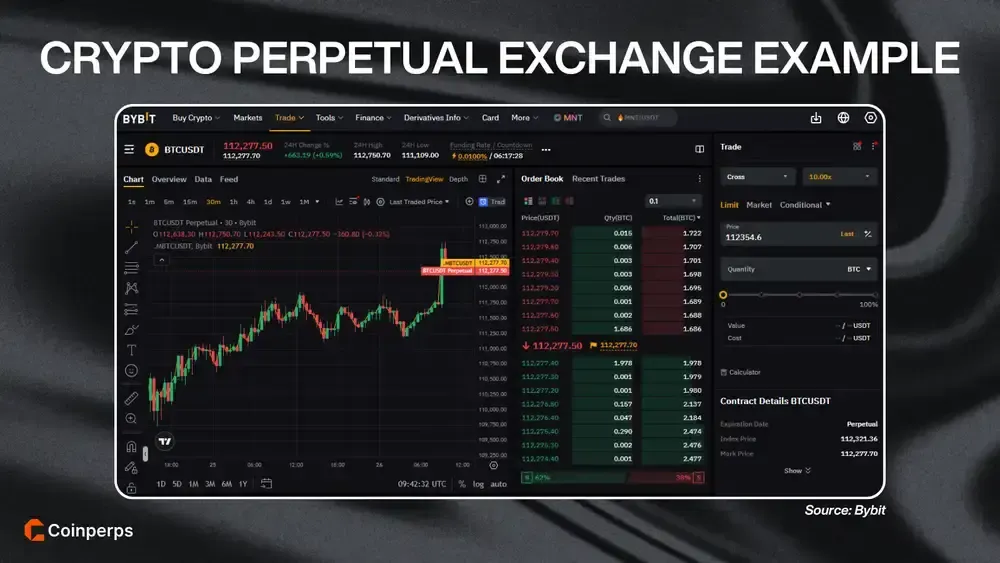
What Are Crypto Futures?
Crypto futures are standardized derivative contracts that let traders agree on a fixed price to buy or sell cryptocurrency at a later date. Each futures contract carries a clearly defined expiration date, after which settlement occurs either in cash or by delivering the underlying asset.
Futures are offered in multiple timeframes, typically weekly, biweekly, monthly, and quarterly cycles, giving traders flexibility over exposure duration. Shorter-dated futures appeal to active traders seeking tactical opportunities, while longer-dated ones suit funds and institutions managing structured hedges.
They provide leverage and price predictability, helping traders speculate or protect portfolios against volatility without directly holding the crypto asset. As expiry approaches, the futures price converges toward the spot market, ensuring alignment between contract value and the asset’s real price.
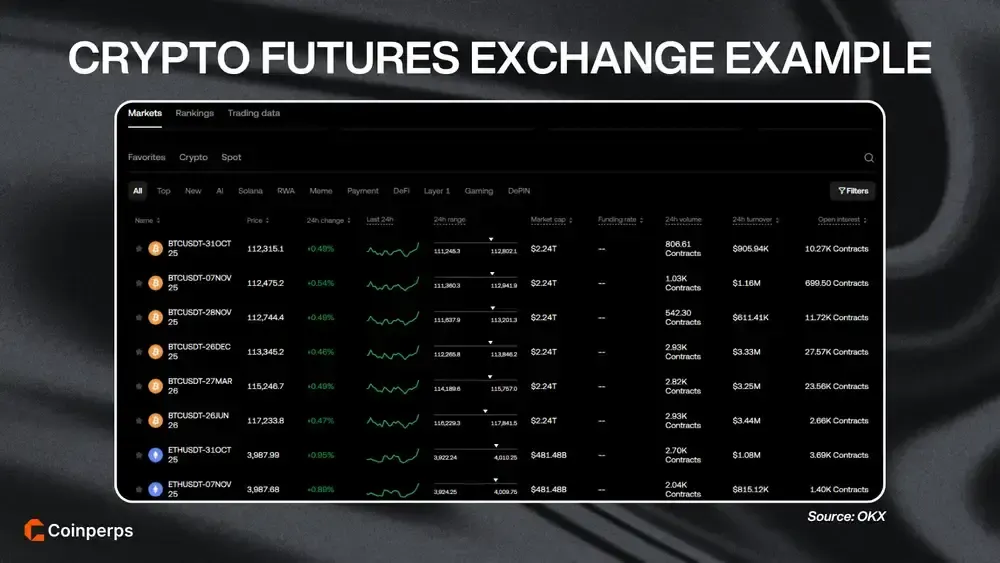
Differences Between Perpetual and Crypto Futures
Perpetuals and crypto futures are both leveraged derivatives but differ significantly in structure, fees, and trading behavior. Here are the main differences between the two contract types:
- Expiration: Perpetuals contracts on exchanges like Bybit have no expiry and remain open indefinitely, while futures always have fixed settlement dates that end the contract.
- Funding vs. Settlement: Perpetuals use ongoing funding payments between longs and shorts to stay near spot price, whereas futures naturally converge to spot at expiration.
- Rollover: Perpetuals never require rollover, but futures traders must close and reopen positions as each contract expires to maintain exposure.
- Price Behavior: Futures prices often trade at a premium or discount depending on expectations, while perpetuals constantly adjust through funding to track real-time spot.
- Cost Structure: Perpetuals involve continuous funding fees, while futures embed carry costs in their initial price spread and charge only trading fees.
- Liquidity Concentration: Perpetuals concentrate liquidity into a single, continuous market, while futures liquidity spreads across weekly, monthly, and quarterly expiries.
- Use Cases: Perpetuals suit active traders seeking round-the-clock flexibility, while futures appeal to institutional players planning defined hedges or regulatory compliance.
Fees in Futures vs Perpetual Crypto Trading
Fees in futures and perpetual crypto trading are the various charges traders pay to open, hold, or close derivative positions across exchanges. They directly affect profit margins, especially for traders using leverage or placing frequent orders in volatile markets.
Most exchanges charge small percentage-based trading fees on every order, called maker-taker fees, which vary by execution type and volume. Market orders (takers) usually cost more because they fill instantly, while limit orders (makers) charge less for adding liquidity to the book.
Perpetual contracts also include funding payments that occur several times daily to align contract prices with the spot market. Futures, in contrast, apply only fixed trading and settlement fees at entry and expiry, making their overall cost easier to estimate.
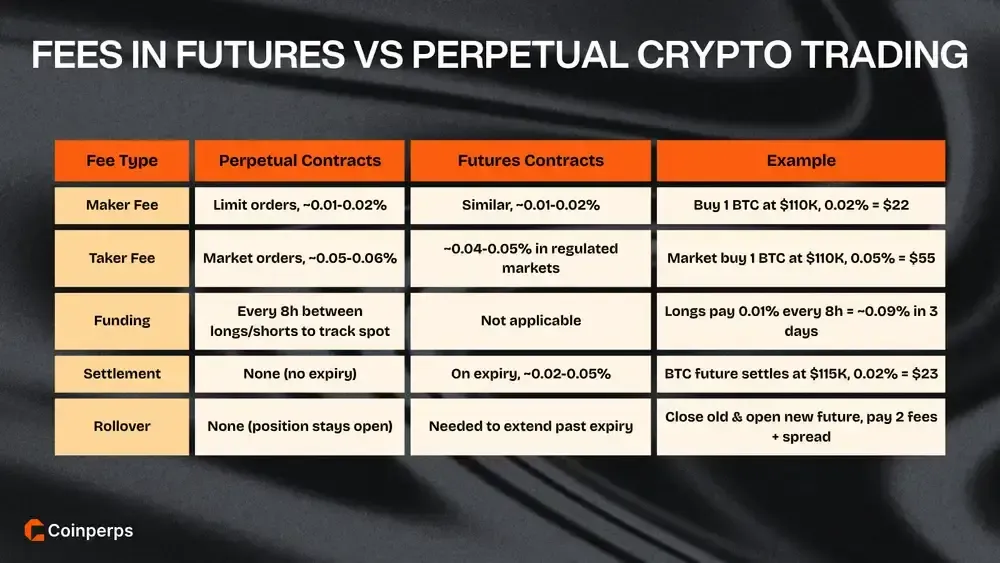
Perpetual Trading Fees
Perpetual trading fees consist of maker-taker commissions and recurring funding payments that keep contract prices aligned with the underlying spot market.
Here are the main components of perpetual fee structures:
- Maker-taker commissions: Exchanges charge between 0.015-0.055%, with examples like Bybit at 0.02%/0.055% and Hyperliquid at 0.015%/0.045%.
- Funding rate charges: These occur every 8 hours and typically range from 0.01-0.05%, where longs pay shorts in bullish markets and shorts pay longs in bearish ones.
- Cumulative holding costs: Continuous funding means long-term or high-leverage positions can accumulate more cost through funding than through trading fees.
Futures Trading Fees
Futures trading fees include only maker-taker execution costs and potential rollover expenses that occur when contracts reach expiration or are renewed.
Here are the key components of futures fee structures:
- Execution costs: Most exchanges charge 0.02-0.05%, such as Kraken at 0.020%/0.050% on standard futures pairs.
- Institutional pricing tiers: Regulated venues like Coinbase Derivatives charge higher rates around 0.40-0.60% to cover compliance and custody requirements.
- Rollover costs: When futures expire, extending exposure requires reopening new contracts, adding spread and trading costs similar to indirect holding fees.
Crypto Perpetuals vs Futures Leverage
Crypto perpetual contracts typically offer far higher leverage limits, allowing traders to amplify exposure with minimal collateral. Major exchanges like Binance and Bybit permit up to 125x leverage, while MEXC offers 500x and Aster pushes the extreme with 1001x on select markets.
In contrast, crypto futures products usually maintain lower leverage caps, commonly ranging from 10x to 20x, occasionally reaching 50x on less regulated venues. This reduced leverage helps manage liquidation risk and aligns with stricter margin requirements often enforced on regulated or institutional platforms.
Perps vs Futures in Decentralized Finance
In decentralized finance, perpetual contracts dominate derivative trading because they can operate continuously without expiries or centralized clearing. True dated futures are rare in DeFi, as managing multiple expirations on-chain would fragment liquidity and complicate settlement.
According to The Block’s DEX to CEX Futures Trade Volume data, decentralized perps reached an all-time high of 14.06%, marking record on-chain market share. This growth was driven primarily by the trading meta created by Hyperliquid and later expanded through DEXs like ApeX, Aster, Lighter, and EdgeX.
These protocols introduced near-centralized exchange performance, deep liquidity, and high leverage options, closing the gap between on-chain and centralized trading. As a result, decentralized perpetuals now represent a meaningful share of global derivatives volume.
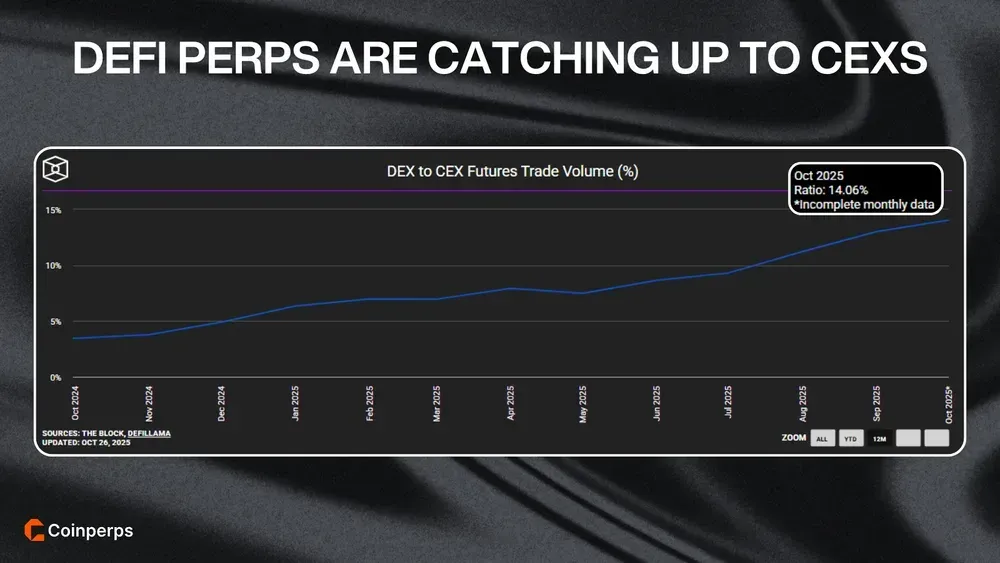
Risks in Perpetuals vs Crypto Futures
Both perpetuals and crypto futures expose traders to amplified risks due to leverage, volatility, and market structure. Understanding how each product handles liquidation, funding, and expiry helps manage exposure and avoid unexpected losses.
Risks in Perpetual Contracts
Perpetuals carry continuous exposure and high leverage, making them especially vulnerable to sudden price movements in 24-hour markets. Main risk factors include:
- Liquidatations: At 100x leverage, even a small 1% move can instantly liquidate the entire position and erase all margin.
- Funding pressure: Recurring funding payments every few hours can quietly reduce profitability when positions are held during strong directional trends.
- Auto-deleveraging: In extreme volatility, exchanges may forcibly reduce profitable positions through auto-deleveraging (ADL) to offset losses from liquidated traders and protect their insurance funds.
Perpetual traders must actively monitor funding rates, margin health, and market volatility to control risk and prevent full liquidation.
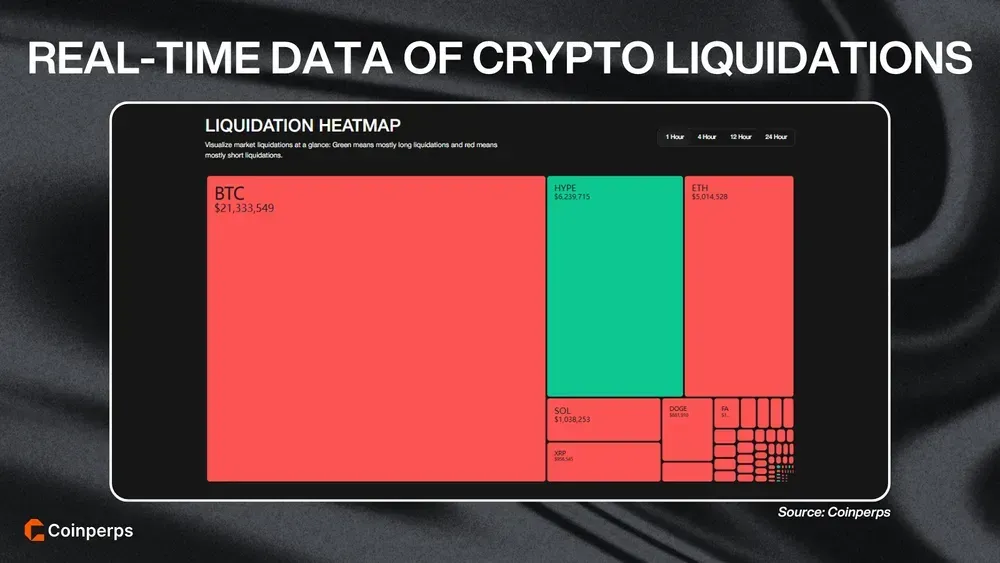
Risks in Crypto Futures
Crypto futures have fixed expirations, meaning traders face risks from settlement mechanics, rollover requirements, and shifting market expectations. Primary risks to consider include:
- Basis volatility: The price gap between futures and spot can widen sharply before expiry, distorting mark-to-market values and potential profits.
- Settlement risk: Near expiry, illiquid contracts can be manipulated or experience squeezes that force artificial price spikes or crashes.
- Rollover costs: Maintaining exposure across multiple expiries adds compounding fees and slippage that gradually reduce long-term returns in volatile markets.
Futures traders should manage expiries carefully, avoid thinly traded contracts, and maintain adequate margin buffers to mitigate forced settlements.
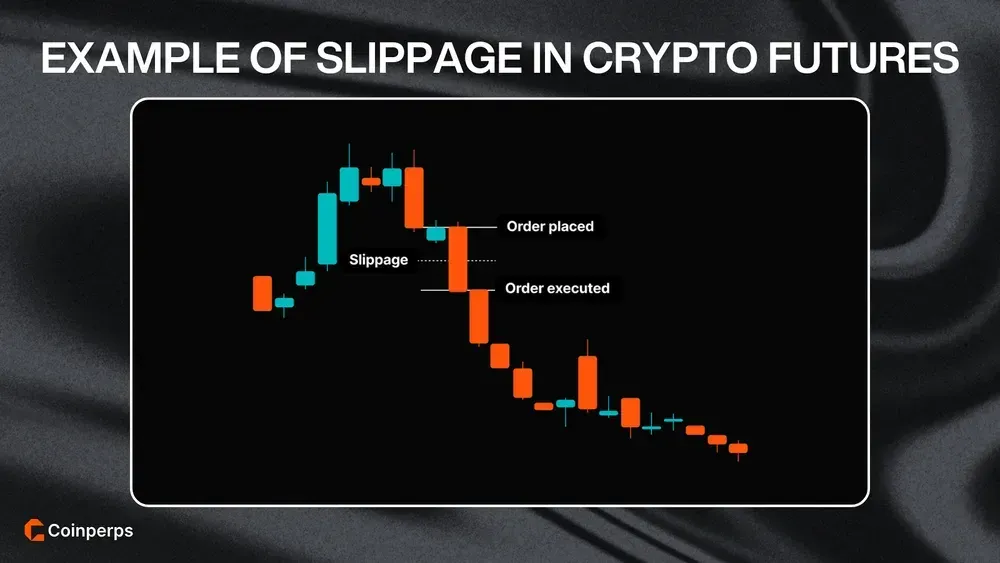
Crypto Taxes for Futures and Perps Traders
Tax treatment for crypto derivatives depends on product type, holding period, and jurisdiction, influencing how profits and losses are ultimately reported.
In most major jurisdictions, futures contracts listed on regulated venues like CME receive more favorable classification and clearer reporting requirements. In the United States, they often qualify as Section 1256 contracts, meaning 60% of gains are taxed as long-term and 40% as short-term, even if held briefly.
By contrast, perpetual contracts traded on offshore or decentralized exchanges are usually taxed as regular crypto property disposals rather than formal derivatives. Each closed trade and funding payment is recognized as a taxable event, often at standard income or short-term capital gains rates.
Bottom Line
Perpetual swaps dominate crypto because they have no expiry, centralized liquidity, and allow long or short exposure with adjustable leverage. Dated futures matter because they match defined timelines, avoid recurring funding fees, and provide clearer regulatory standing and taxation advantages.
Select the instrument based on timeline, funding versus rollover costs, and regulatory comfort, because each structure serves a strategic purpose. Perpetuals benefit traders managing funding and liquidation constantly, whereas dated futures benefit planners seeking known maturities and quarter-end reporting.
Frequently asked questions
Yes, many major exchanges like Binance, OKX, and Bitget offer both products, allowing traders to switch between perpetuals for flexible exposure and futures for time-defined hedges within a single account.
Collateral varies by platform: centralized exchanges often use USDT, USDC, or BTC as margin, while DeFi platforms like Hyperliquid and Aster allow multi-asset collateral, including ETH, stablecoins, or LP tokens.
Not always. Funding can sometimes favor shorts, meaning traders receive payments instead of paying them. However, during strong trends, funding usually turns costly for the dominant side, increasing long-term holding expenses.
Centralized exchanges rely on internal risk systems and insurance funds to handle liquidations, while DeFi platforms execute transparent smart-contract liquidations that automatically distribute losses and maintain collateral solvency on-chain.
.avif)